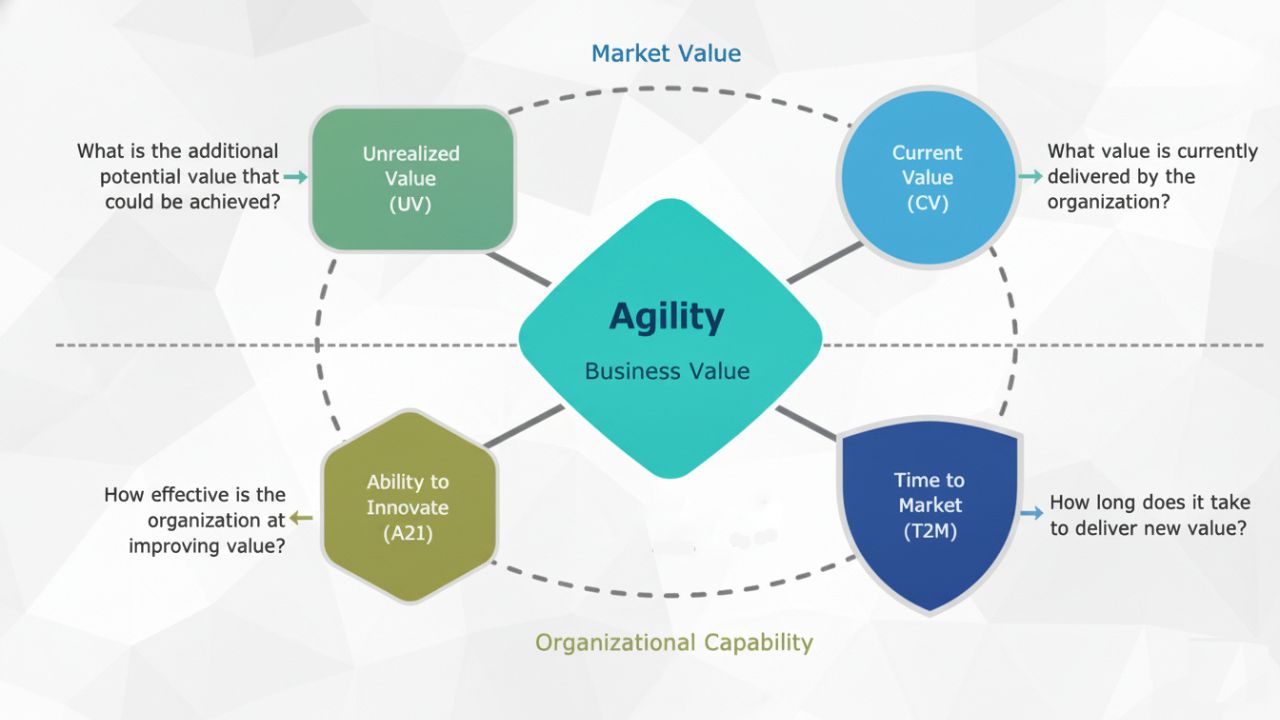How to Measure Business Value and Improve Company Performance?
Companies that adopt Agile practices often lose sight of their ultimate goal: genuine improvement in business value. Instead of focusing on end results, they get caught up in measuring only activities and operational metrics. Agile is not the goal, but a means to achieve it. When this is forgotten, managers ask the wrong questions that lead to misconceptions.
Why measuring only Agile metrics is not enough?
Questions like “How many sprints have we completed?” or “Has our velocity increased?” are interesting, but they don’t tell us whether we’ve delivered real value to users. Team velocity doesn’t measure whether value or “software waste” is being delivered.
The solution lies in an approach called Evidence-Based Management (EBM). EBM enables you to measure the actual business value you deliver and make decisions based on facts, not assumptions.
What is Evidence-Based Management (EBM)?
EBM is an empirical approach that helps organizations: * Measure the value they deliver to their customers. * Identify ways to improve the delivery of that value. * Use these metrics for comprehensive business and work culture improvement.
EBM relies on four Key Value Areas (KVAs). They represent different aspects of a company’s value and capabilities. If you neglect any of them, you may achieve short-term gains but will lose competitive advantage in the long run.
4 Key Value Areas (KVA) for Sustainable Success
These are the four pillars on which the measurement of real business value rests.
1. Current Value (CV)
What it measures: How much business value your product or service provides to customers today. Goal: Maximize satisfaction and value for all stakeholders. Key questions: * How satisfied are our users and customers? Is their satisfaction increasing? * How satisfied are our employees? Are they motivated and productive? * How satisfied are our investors and other stakeholders?
Why it’s important: Happy employees create better products, and satisfied customers remain loyal. Improvements in user experience or work environment directly increase CV.
2. Time-to-Market (T2M)
What it measures: The company’s ability to quickly deliver new features, services, or products. Goal: Minimize the time required to deliver value. Key questions: * How quickly can we test a new idea and learn from it? * How quickly can we adapt to new information? * How quickly does new value reach the customer?
Why it’s important: Speed is crucial in modern business. Improvements in automation, internal communication, and system maintenance directly affect T2M.
3. Ability to Innovate (A2I)
What it measures: The company’s ability to develop new capabilities that better meet customer needs. Goal: Maximize innovation and the ability to bring new solutions. Key questions: * What prevents our teams from delivering new, innovative value? * What prevents our customers from accepting and benefiting from these innovations?
Barriers to innovation can be: * Too much time spent fixing bugs. * Complex, monolithic software architecture. * Lack of adequate testing environment. * Centralized decision-making that slows down teams.
Why it’s important: If money and time are spent maintaining obsolete features, no resources remain for innovation.
4. Unrealized Value (UV)
What it measures: The future potential value that could be realized if the company perfectly fulfills the needs of all potential customers. Goal: Maximize the future value of the product over time. Key questions: * In which market can we create additional value? * Is it worth investing additional effort and risk to realize this potential? * Where should we direct our investments?
Why it’s important: UV helps you make strategic decisions about where to invest. A product with low CV but high UV (e.g., a beta version in a growing market) is a good candidate for investment. A mature product with high CV and low UV is likely near the end of its life cycle.
How to Implement EBM: The Learning Loop in 5 Steps
To achieve lasting improvements, establish a continuous learning cycle:
- Quantify Value (Key Value Metrics – KVM): Define concrete metrics for each KVA (e.g., Net Promoter Score for CV, time between releases for T2M).
- Measure the Initial State: Establish baseline values for your KVMs to have a basis for comparison.
- Select KVA for Improvement: Decide which value area will most impact your business (e.g., accelerate T2M or increase A2I).
- Conduct Experiments: Implement changes you believe will improve the selected KVA (e.g., introduce better CI/CD automation for T2M).
- Evaluate Results: Compare new metrics with the baseline. If there was improvement, adopt the change. If not, try other experiments.
This cycle repeats, leading to continuous progress.
Conclusion: From Activities to Results
Transitioning from measuring only activities to measuring real business value is a crucial step toward sustainable success. Start using the four Key Value Areas today to gain clear insight into where your opportunities for advancement lie.
Evidence-Based Management (EBM) is not just theory; it’s a practical framework that enables you to make smarter, data-driven decisions and transform your organization toward agility that truly delivers results.
Start now: Choose one KVA, measure it, and begin your first learning cycle.
Learn more how Scrum can help your business: https://www.whatisscrum.org/scrum_guide.html
Source: Adapted from “EBM – Evidence-Based Management Guide”.
